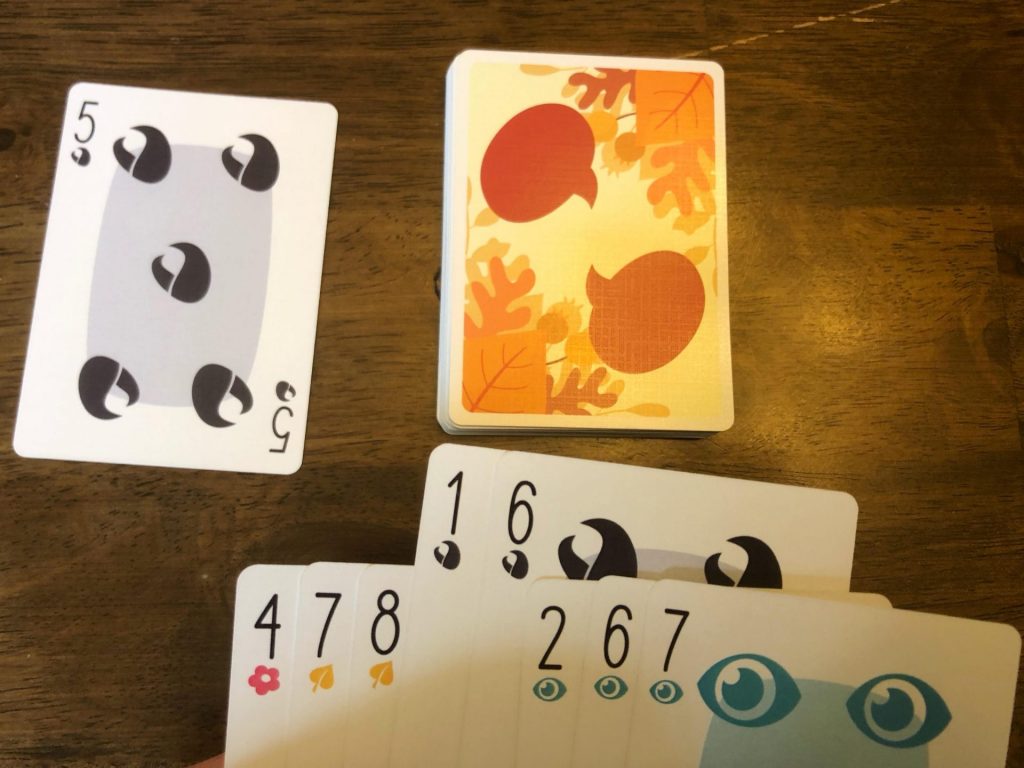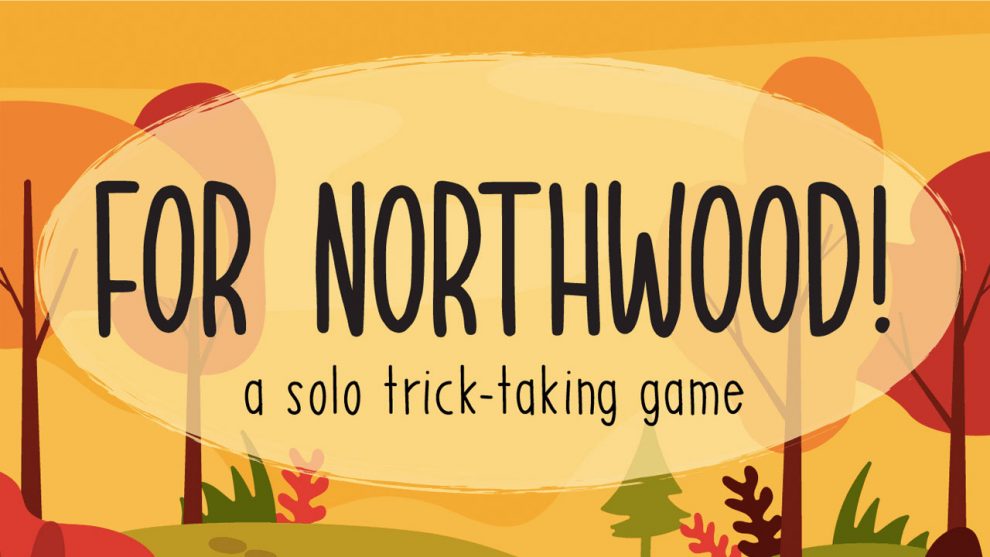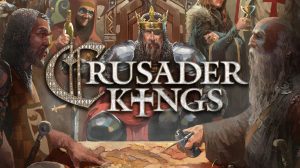Trick-taking games, long considered the bastion of traditional games like Euchre or Spades, have started gaining a lot of traction among tabletop enthusiasts in the last few years. As my colleague Justin points out in his review of Wicked and Wise, classic trick-takers are popular in large part because of the social interaction: the strategic dance of bidding and bluffing, the joy of taking a seemingly impossible trick to hit your bid and the misery of having your perfect run spoiled by an opponent (or a careless partner!). Which makes For Northwood!, a trick-taking game designed for solo play only, seem like a bit of an odd duck.
In For Northwood! you’ll coerce your creature compatriots—each of whom rules a fief in the titular area of Northwood—to form a single kingdom united, presumably, under your rule. To do that, you’ll need to visit each fief and convince them using the power of your available arguments. Sharpen your claws and open your eyes to get these honorable underlings on your side!
The Animal Kingdom(s)
For Northwood! consists of a deck of 66 cards. The most important of these are the 32 dialogue cards uniquely ranked 1-8 across 4 suits, similar to a traditional deck of cards. The remainder includes 24 distinct animal cards to show allies and rulers, 8 fief cards and 2 positioning cards used to show the active fief and the values of each fief.

A game of For Northwood! takes place over 8 rounds (exactly one for each fief). Each round, the player looks at their hand of 8 cards before choosing an unattempted fief to visit. The fiefs are arranged in order of the number of tricks required to successfully complete them, ranging from 0 on the far left to 7 on the far right. Note that these values require precision: win even a single trick while visiting the leftmost fief and you’ll lose the round. Each fief has a randomly determined ruler, who sets the trump suit for any tricks during that round.

A round consists of a variable number of tricks, each framed as a “statement” from the ruler and the player’s “response” which either irritates or helps persuade the ruler in question. The player flips the top card of the deck, setting the card to beat in the same way that a player might lead in a game of Euchre or Bridge, then picks a card from hand to play in response. As with most trick-taking games, the player must follow suit if possible. The suit matching the ruler being visited is trump. A trick is won if the player plays a higher card of the led suit or a card of the trump suit. If the player wins the trick, they place their card in the scoring pile to the right of the deck; if they lose, they place it in the discard pile to the left. (The led card is always discarded.) The player runs through tricks in this way until either their hand or the deck is out of cards. If the round ends with the exact number of needed tricks in the scoring pile, the player wins the fief. Otherwise, they lost the fief.

Before each trick, the player may also use one of their four allies’ special abilities. These offer powerful effects, like being able to draw or discard cards or swap rulers from one fief to another. However, each one can only be used once per round, so getting the timing right is important. The player may also swap in any rulers they’ve successfully swayed in previously completed rounds to replace their default allies; these come with the added caveat that they must be discarded after the round, whether their ability is used or not.
At the end of the basic game, the player reveals the back of each fief card. If all three starred fiefs were completed, the player wins the game. Using the advanced rules, the player instead loses only when they fail one of the four outermost fiefs (values of 0, 1, 6, and 7 tricks). In both cases, a winning player can also track their high scores based on how many fiefs they completed successfully.
Creature Comfort
As I mentioned in my review of Hunted: Mining Colony 415, I’m always intrigued by solo games that use multiplayer-focused mechanics. Translating a mechanic that doesn’t seem to be possible with just one player takes a lot of skill and could easily fall flat. However, Side Room Games has bottled that lightning twice before with Maquis and Black Sonata, so naturally I jumped at the chance to take For Northwood! for a spin.
And I’m incredibly glad I did. The trick-taking element here is flawless, offering a lot of strategy and tension even without anyone else involved. The key lies in the precision needed each round. Whatever the contents of your hand, you have to match it up against one of the available rulers. Sometimes it works out well: you’re long on a ruler’s suit and they need a high number of successful tricks. Other times it works out terribly: your hand is a mess of medium-high cards across all four suits and the only ruler left needs you to win exactly two tricks. Far more often, the hand you thought was a perfect match ends up over- or under-performing, making you frantically draw or discard cards to try and salvage what should have been an easy round.

I love the Mega Man-esque decision around the order of pursuit, too. While I rarely chased a specific ruler’s ability, players can absolutely craft a strategy around those effects if they so choose. I have faith that a better player than me can look at the board and immediately know the proper order in which to pursue each ruler, adjusting it only slightly for the vagaries of the cards in hand. Me? I went for whatever fief I thought I could win at the moment—which generally cost me in the long run as I labored to complete whatever was left on the board. Often I’d back myself into a corner and consequently lose the last round or two.
That is particularly frustrating because, for all its great gameplay, the victory conditions in For Northwood! feel underdeveloped. Using the basic rules, the player must get all three starred fiefs for a win – but the stars are hidden until the end of the game. You won’t know until then whether that ruler you missed in the very first round was one of the three you needed, which can be extremely anticlimactic (unless you cheat and look early, which is also unsatisfying). The advanced rules are almost as bad: you can lose the four inner fiefs without problem, as long as you take all four of the outer fiefs. A trick-taking game where you can fail half of your rounds and still walk away with a win just doesn’t sit right with me. It’s an easy fix, of course; I just don’t count anything with fewer than eight fiefs as a win. I don’t mind losing the “beat your own score” aspect, and the added challenge makes every victory even sweeter.

I also struggle a bit with the game’s theme. While I genuinely like the concept of persuading disparate fiefs ruled by petty nobility to form a cohesive national structure for their mutual well-being, I know that premise sounds dry as dirt for many gamers. Cloaking the abstract gameplay in a cozy woodland setting definitely gives it a broad appeal, a charm that it would otherwise lack. Look at those cute little creatures with their bows and their hats and their crowns! Unfortunately For Northwood! never really brings it all together. When a ruler’s statement is “6 of Leaves” and you respond with “4 of Claws”, it’s hard not to notice the mechanical scaffolding. And while the illustrations are both adorable and technically well-made, they don’t particularly stand out, either.
On the plus side, the theme and art allows parents to play this cooperatively with their kids, which is worth quite a bit in my book. My daughter and I had a great time playing this together. We cried out “For Northwood!” with glee every time we completed a fief. We discussed strategy and dissected probabilities. We laughed at my insistence on using certain abilities even though they rarely worked for us. I don’t know that we ever would have tried that had the theme been something drier or more historical, so in that sense I think the theme absolutely works.
As a whole, For Northwood! is a game I’m glad to have around. It plays fairly quickly, has a good mix of tactics and strategy, offers compelling gameplay, and fills an interesting solo (or light cooperative) niche. It won’t be the first solo game I grab off the shelf most nights, but it’ll definitely be in the rotation. I’d give it an extra bump for parents looking for something with a bit of challenge to play with an elementary-schooler. Despite a few flaws, For Northwood!’s fresh twist on a classic mechanic is a crowning achievement that’s worth visiting at least once.











Add Comment